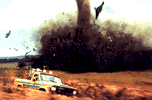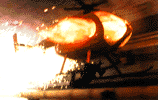Spotlight : December 1996
The Magic of ILM
By Todd Vaziri
Spotlight : December 1996
The Magic of ILM
By Todd Vaziri
If you've visited the Effects Houses section of the
VFX HQ, you have seen over a dozen of the biggest names in visual effects. Every
house listed creates great images for today's feature films. Although parity of the
industry exists, there is a definitive leader of the pack: Lucas Digital's Industrial Light & Magic (ILM).
Effects technology has become much cheaper over the years, and the capital it takes to
start a new company has slowly been shrinking. Software like Softimage is now
available to the consumer market, and SGIs are becoming a bit more affordable. Also,
the talent pool seems to be getting larger as universities train students on valuable
animation software.
Amidst all of the competition, ILM remains on top. They have the experience, the
creativity, the tools, the history and the power to work on high profile shows and
consistently perform well. The folks who built ILM pioneered the use of many
techniques that are commonplace today. Think of how important CG imagery is in
today's films. Where did feature film's use of CG begin? The most significant step
in CG, in my opinion, was 1982's STAR TREK II: THE WRATH OF KHAN, whose dramatic
Genesis simulation was an entirely computer generated sequence, the first of its kind.
The group that worked on the sequence at ILM later separated from LucasArts and became
a company called Pixar, whose TOY STORY represented yet another huge step in CG
animation.
The Pixar example is just one of many arms of ILM's far-extending reach. Nearly every
respected effects veteran is or was connected to ILM. The president of Sony Pictures Imageworks, Ken Ralston, spent almost two
decades at ILM. Richard Edlund, who was integral to the effects of STAR WARS founded
his own company, Boss Film Studios. Phil Tippett, the
go-motion innovator, did the same and is currently running Tippett Studios. Digital Domain was founded by three men, all of which had
serious relationships with ILM; James Cameron worked with ILM on THE ABYSS and T2,
Stan Winston collaborated with them on JURASSIC PARK and T2, and Scott Ross was ILM's
general manager.
The continuing power of ILM is also due to the snowball effect. ILM revolutionized
effects in 1977, they get more high-profile, big-budget projects, ILM grows, the tools
and resources expand, ILM gets more big-budget projects, ILM expands its talent, ILM
gets another $80 million movie, etc.
High profile, risky projects are nothing new to ILM. No matter what imagery is
presented before them in a screenplay--not even if the technology isn't available
yet--the effects house comes through with stunning results. A mysterious water
tentacle? "We can do that (THE ABYSS)." Fully computer generated dinosaurs? "We can
do that (JURASSIC PARK)." A chase scene with a virtual helicopter, a virtual train
and a virtual tunnel? "We can do that (MISSION: IMPOSSIBLE)." They are constantly
given the impossible and achieve it.
Owner George Lucas has crafted the company into an image factory. Easily the largest
of all the effects houses, ILM is sometimes criticized for its 'assembly line'
attitude in creating visual effects. No matter how ILM runs its business, they are at
the top of their game.
The effects industry should be very proud of itself right now. Fantastic images are
being created by the big companies, like ILM and Digital Domain, as well as other
companies like Boss Film and Rhythm & Hues. But ILM
is the heart of the industry--they are the most consistent effects house in terms of
quality and quantity of images. The company is synonymous with special effects
because of its rich history and continually expanding resources and talent.
 The past ten years
have been extraordinary for ILM in terms of the shows on which they've worked. (Never
mind the fact that ILM provided effects for such blockbusters as E.T., RAIDERS OF THE
LOST ARK, the STAR WARS trilogy, etc.) Since 1987,
ILM has earned seven out of nine Academy Awards for visual
effects. Just like other effects houses, ILM must prove its worth during the
negotiations period--productions do not simply hand off their project to ILM blindly.
Take TWISTER, for example. Director Jan DeBont and
producer Steven Spielberg needed to be convinced that a CG tornado would work on film,
or else the picture wouldn't have been made at all. The ILM test team was led by
effects veteran Dennis Muren, and consisted of fx producer Kim Bromley, animator Dan
Taylor, and CG artists Scott Frankel, Carol Hayden, Stewart Lew and Scott Frankel.
The test was overwhelmingly successful--you may have even seen it. It was so
fantastic, Warner Bros. attached it to the end of the teaser and trailer for the film.
The past ten years
have been extraordinary for ILM in terms of the shows on which they've worked. (Never
mind the fact that ILM provided effects for such blockbusters as E.T., RAIDERS OF THE
LOST ARK, the STAR WARS trilogy, etc.) Since 1987,
ILM has earned seven out of nine Academy Awards for visual
effects. Just like other effects houses, ILM must prove its worth during the
negotiations period--productions do not simply hand off their project to ILM blindly.
Take TWISTER, for example. Director Jan DeBont and
producer Steven Spielberg needed to be convinced that a CG tornado would work on film,
or else the picture wouldn't have been made at all. The ILM test team was led by
effects veteran Dennis Muren, and consisted of fx producer Kim Bromley, animator Dan
Taylor, and CG artists Scott Frankel, Carol Hayden, Stewart Lew and Scott Frankel.
The test was overwhelmingly successful--you may have even seen it. It was so
fantastic, Warner Bros. attached it to the end of the teaser and trailer for the film.
 ILM has brought about
effects revolutions; techniques such as the morph and CG creation and animation were
used effectively in their shows. They successfully graduated from the optical world
to the digital world. Just look at the compositing in MISSION: IMPOSSIBLE and TWISTER. It is impeccable.
ILM has brought about
effects revolutions; techniques such as the morph and CG creation and animation were
used effectively in their shows. They successfully graduated from the optical world
to the digital world. Just look at the compositing in MISSION: IMPOSSIBLE and TWISTER. It is impeccable.
Back to the Spotlight Main Menu

. . VFX HQ Produced by Todd Vaziri . . http://www.vfxhq.com . . e-mail: tvaziri@gmail.com . .
All text Copyright © 1998 Todd Vaziri, unless otherwise noted